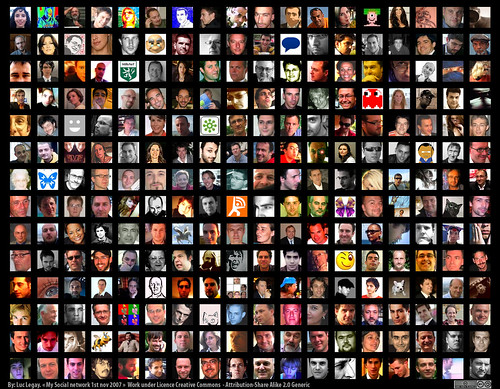The talk essentially mashed together ideas from some other research projects and presented some new material geared toward pedagogical approaches and student engagement.
This last bit was perhaps the most interesting, as it drew from the Ball State University Fall 2008 "Making Achievement Possible" survey of first-year students. The MAP Works survey indicates that 46% of first-year BSU students spend between 30 minutes and two hours on social networking websites each day. A full 40% of students spend 2 or more hours each day on such sites. My sense is that these numbers are underreported.
In other words, 86% of our first-year students, as of 2008, are spending time every single day with communities that look like this:

Creative Commons image by luc legay on Flickr.
I asked: as an educator, where are you in that picture? Where are the influential scholars and teachers in your field? Do we see their avatars represented in the social networks where our students are spending their time? Should they even be there in the first place?I don't have any easy answers to those questions, but I did suggest some ways that faculty at Ball State can incorporate microblogging into their curricula and pedagogies. I've embedded the slides from today's talk below, and as always, I'm happy to provide a transcript as well. Tommy and Ben from the Center for Media Design were there shooting some video, and I assume it will eventually surface at some point; when it does, I'll link to it!

2 comments:
I think twitter would be a great way to connnect with your students, maybe if they got stuck on something they could tweet you their question and you could tweet back the response.
I remeber a teacher gave us all his number in high school and said call if we need help, nobody was really comfortable with that, but I think if we would of had twitter back then I would of been comfortable with that.
@jessica
Yes, great point! And the interaction needn't only be with the instructor, but with the kinds of folks who could help students in a given area, from across professional domains.
Quicker and easier than email, and mobile for any student who owns a cell phone and can send/receive text messages.
Post a Comment